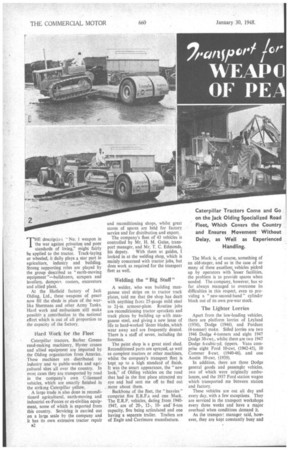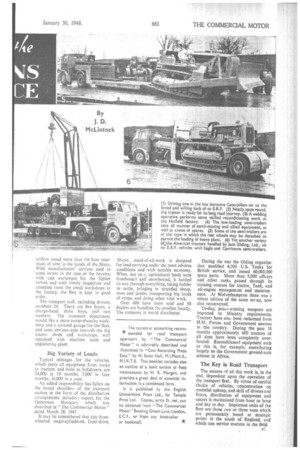T HE descriptio " No. 1 weapon in the war against
Page 36

Page 37

If you've noticed an error in this article please click here to report it so we can fix it.
privation and poor standards of living," might fairly be applied to the tractor. Track-laying or wheeled, it daily plays a star part in agriculture, industry and building. Strong supporting roles are played by the group described as "earth-moving equipment "—bulldozers, scrapers and levellers, dumpers rooters, excavators and allied plant.
At the Hatfield factory of Jack Olding. Ltd., these weapons of peace now fill the sheds in place of the warlike Shermans and other Army Tanks. Hard work and enthusiasm still make possible a contribution to the national effort which is out of all proportion to the capacity of the factory.
Hard Work for the Fleet
Caterpillar tractors, Barber Greene road-making machinery, Hyster cranes and allied equipment are imported by the Olding organization from America. These machines are distributed to industry and to public-works and agricultural sites all over the country. In most cases they are transported by road in the company's own C-licensed vehicles, which are smartly finished in the striking Caterpillar yellow.
A large trade is also done in reconditioned agricultural, earth-moving and industrial ex-Forces or ex-civilian equipment, some of which is exported from this country. Servicing is carried out on a large scale by the company and it has its own extensive tractor repair a2 and reconditioning shops, whilst great stores of spares are held for factory service and for distribution and export.
The company's fleet of 43 vehicles is controlled by Mr. H. M. Guise, transport manager, and Mr. T. C. Edmonds, his deputy. With them as guides, I looked in at the welding shop, which is mainly concerned with tractor jobs, but does work as required for the transport fleet as well.
Welding the "Big Stuff"
A welder, who was building manganese steel strips on to tractor track plates, told me that the shop has dealt with anything front 25-gauge mild steel to 2i-in armour-plate. Routine jobs are reconditioning tractor sprockets and track plates by building up with manganese steel, and giving a new lease of life to hard-worked 'dozer blades, which wear away anti are frequently dented. There is a staff of seven, including the foreman.
The paint shop is a great steel shed. Reconditioned parts are sprayed, as well as complete tractors or other machines, whilst the company's transport fleet is kept up to a high standard of finish. It was the smart appearance, the "new look," of Olding vehicles on the road that had in the first place attracted my eye and had sent me off to find out more about them.
Backbone of the fleet, the "heavies" comprise five E.R.F.s and one Mack. The E.R.F. vehicles, dating from 19401947, are of 20-, 12-, 10and 8-ton capacity, five being articulated and one having a separate trailer. Trailers are of Eagle and Carrimore manufacture.
The Mack is, of course, something of an old-stager, and as in the case of so many of these excellent. vehicles picked up by operators with lesser facilities, the problem is to provide spares when needed. The company, however, has so far, always managed to overcome its difficulties in this respect, even to providing a " new-second-hand " cylinder block out of its own pre-war stock.
The Lighter Lorries
Apart from the low-loading vehicles, there are platform lorries of Leyland (1936), Dodge (1946), and Fordson (4-tonner) make. Sided lorries are two 1946 Dodge 4-tonners and eight 1947 Dodge 30-cwt., whilst there are two 1947 Dodge 6-cubic-yd. tippers. Vans comprise eight Ford 10-cwt. (1942-45), 10 Commer 8-cwt, (1940-46), and one Austin 10-cwt. (1939).
In addition, there are three Dodge general goods and passenger vehicles, two of which were originally ambulances, and the 1937 Ford station wagon which transported me between station and factory.
These vehicles are out all day and every day, with a few exceptions. They are serviced in the transport workshops every three weeks and have a major overhaul when conditions demand it.
As the transport manager said, however, they are kept constantly busy and
seldom spend more than the bare minimum of time in the hands of the fitters. With manufacturers' services used to some extent in the case of the heavies, with unit exchanges for the lighter lorries and with timely inspection and attention from the small workshops at the factory, the fleet is kept in good order.
The transport staff, excluding drivers, numbers 24. There are five fitters, a charae-hand, three boys, and two washers. The transport department would like a more comprehensive workshop and a covered garage for the fleet, and casts envious eyes towards the big tractor sheds and workshops, well equipped with machine tools and engineering plant.
,Big Variety of Loads
Typical mileages for the vehicles, which carry all equipment from tracks to tractors, and bolts to bulldozers, are 34,000 in 19 months, 7.000 in four months, 16,000 in a year, An added responsibility has fallen on the broad shouIclets of the transport section in the form of the distribution arrangements, includin export, for the Opperman Motocart, which was described in "The Commercial Motor" dated March 28, 1947 It may be remembered that this threewheeled, single-cylindered, front-drive,
30-cwt. maid-of-all-work is designed for load-carrying under the most adverse conditions and with notable economy. When, last yen-, agricultural lands were frostboual and snowbound, it battled its way through everything, taking fodder to cattle, bringing in stranded sheep, ewes and lambs, transporting big loads of crops, and doing other vital work.
Over 600 have been sold and 50 dealers are handling the product locally. The company is world distributor. During the war the Olding organization modified 4,500 U.S. Tanks for British service, and issued 60,000,000 spare parts. More than 5,000 officers and other ranks passed through its training courses for tractor, Tank, and oil-engine management and maintenance. At Wolverhampton there was a minor edition of the same set-up, now also reconverted.
To-day, pea'-winning weapons are imported to Ministry requirements. Tractor" have also been reclaimed from H.M. Forces and Government sources in this country. During the past 18 months approximately 600 tractors of all sizes have been completely overhauled. Reconditione4 equipment such as this is, for example, contributing largely to the Government ground-nuts scheme in Africa.
The Key is Road Transport
The success of all this work is, in the end, dependent upon the operation of the transport fleet. By virtue of careful choice of vehicles, concentration on essential upkeep, and skill of drivers and fitters, distribution of equipment and spares is maintained from hour to hour and day to day. Important units of the fleet are those two or three vans which are permanently based at strategic points in the south of England, and which can service tractors in the field.
























































































